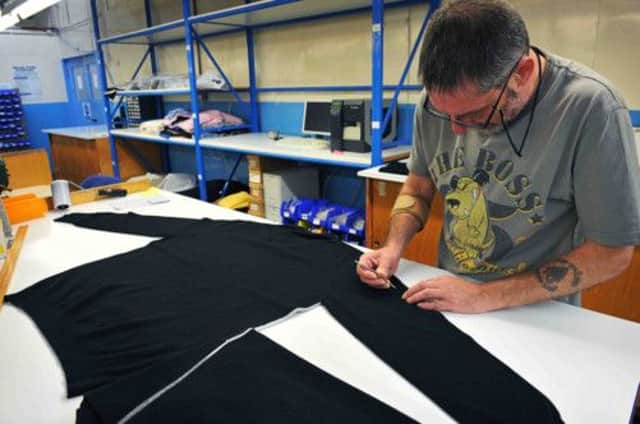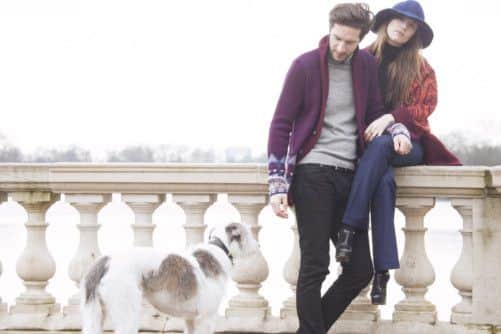Matthew Williamson for Ballantyne: The art of colour


His trademark is vibrant, dynamic colour, his inspiration as often as not the souks of Morocco or the silks and saris of the Far East. Yet Matthew Williamson reveals his favourite item in his first and forthcoming collaboration with knitwear label Ballantyne is not the colour-popping fuchsia sweater with red and pale pink intarsia, nor the burnt orange roll-neck, or even the finely-detailed jacquard jacket in deep rust. Rather, of all the covetable cashmere in the collection, the single piece he is most proud of is a simpler, less predictable option from this master of colour.
“It’s actually the black and white jumper,” he confirms, laughing. “I just think it’s an eye-catching piece. It’s quite tongue in cheek, it’s versatile, with a tile pattern – and nestled in the pattern are two little love birds.”
Advertisement
Hide AdAlso surprisingly, but fittingly, the inspiration for this collection wasn’t so much the exotic destinations he has reflected in past seasons, but much closer to home. “I started playing with a kind of eccentric British sensibility,” he explains of the designs, which take the traditional Fair Isle and Argyle patterns of old but give them a 21st-century edge.


“Ballantyne is quite safe with its collection – it’s much more commercial and mainstream – so I wanted to inject more impact and levels of colour and pattern. It’s loosely based on the idea of an English rose.”
Ballantyne approached Williamson a year ago, he explains. “Essentially they wanted to add to their existing core collection a younger, more fashion-forward line. They were keen on the DNA of our brand and the use of brighter colours and bold patterns and so on, and we’re trying to build our core knitwear line anyway, so we decided it would be a good synthesis for the two brands.”
The appeal of making the collection in Italy, using the finest Scottish cashmere, meant the decision was a no-brainer. “Working with the Italian manufacturing unit, there’s a certain level of quality and craftsmanship there that is becoming rarer and rarer to find,” he says. “It was nice to be able to work with them and know we were going to get a high standard of product.
“Sometimes over the years it’s been hard to do our cashmere in Scotland because of the price issue,” he adds, “but it’s undoubtedly the best I’ve ever worked with.”
Born in Chorlton, Manchester, in 1971, even from an early age Williamson was drawn to fashion – to the bright colours and the way it could transform a person – and was convinced, from the day he knew what a fashion designer was, that was what he would become. “I was fascinated by my mum as a little boy,” he says, “how she used fashion to her advantage. She stood out for me in a quite mundane, relatively grey environment. To me, she was a bit of a firefly. She used fashion to make herself feel better and she was definitely an initial spark to my creativity. She really nurtured the fact that I loved to draw and paint.”
Advertisement
Hide AdBoth his mother, the manager of an opticians, and his father, a television salesman, encouraged this fledgling talent, buying the creative youngster a sewing machine for his birthday instead of the standard football boots (his father had named him after the legendary Manchester United manager Sir Matt Busby).
Later, when his career was beginning to take off, they went even further, selling their house and moving to London to help him set up his business. Mama Williamson was a popular Saturday girl in his first Mayfair store. “She moved from Manchester to London and was due to be there for three months and stayed for seven years,” says her proud son (it is also notable that neither parent has missed a single catwalk show – or an after-party – in his entire career).
Advertisement
Hide AdHe chose to study at Central Saint Martins on the basis that was where John Galliano had gone – though he chooses not to comment on the former Dior designer’s fall from grace – and for his first collection, entitled Electric Angels, in 1997 – a pared-down runway show featuring just 11 outfits in tangerine, violet and electric blue that was over in just four minutes – the relatively unknown but promising designer somehow roped in Kate Moss, Helena Christensen and Diane Kruger for modelling duty.
How on earth did he manage that?
“The honest answer is it just happened by chance,” he says. “I had a fleeting meeting with Jade Jagger, who came across one of my pieces that I’d sent to Vogue. She was modelling and loved this dress I’d made so got in touch with me. A couple of months later we were best mates and she really inspired me at the time, as I was preparing to do a collection. She kind of cajoled me to do the show and before I knew what was happening I had Kate Moss in my bedroom – she’s always ahead of the curve and known for being one step ahead and wanted to be part of it. It wasn’t a plan, it was an organic process.”
He has been a celebrity favourite ever since, with Sienna Miller, Olivia Palermo, Andrea Riseborough, Thandie Newton and Kylie Minogue wearing his designs, and few red carpet occasions pass by without at least one Williamson frock making an appearance. Indeed, in 2008 he won Red Carpet Designer of the Year at the British Fashion Awards (he has also been nominated for Designer of the Year three times). It’s all very nice and everything, but he brushes off the importance of celebrity endorsement, insisting it’s all simply part of the business these days and what really matters is that people continue to buy his clothes, season after season.
“If you look at most designer brands, they have an affiliated actress or model or pop star or whatever. I think my position is not very different to 99.9 per cent of designers – it’s what you do. If you can find a great brand ambassador and high-profile girl who represents what you do well, it’s kind of a given that that’s the way it goes.”
But while there’s a floaty, boho aesthetic to his garments – a sense of joss sticks and love beads and butterflies – there’s a harder edge to Williamson, who is a canny businessman and no shirker in the grafting stakes. A year after opening his store in Mayfair in 2004 he launched a perfume line and the following year he was appointed creative director at Pucci. He stayed in that post until 2008, when he returned full time to concentrate on his own label. He is now celebrating nearly 16 years of success. After ten years, in 2007, the Design Museum in London marked his career with a retrospective exhibition; his 15th anniversary involved a short film starring Sienna Miller, eight Royal Ballet dancers and a harem of models and It girls.
So, any secrets to pass on?
“I would say a million and one things,” he considers, “but at the top of my list would be drive and passion and believing in yourself and in your vision. If you don’t have that you don’t have anything to build on. Then there’s hard work, long hours, a great team, having an eye for business. You could write a book on it, but ultimately it’s about having steadfast belief in what you’re doing and having a passion for it. That’s a rare and fortunate position to be in; to be able to get out of bed and want to go to work and love what you do. I feel lucky that I still love it.”
Advertisement
Hide AdHe has also, in the past, said he wouldn’t be where he is without business partner – and former life partner – Joseph Velosa, whom he met while still at Central Saint Martins and who originally persuaded Williamson to send the Electric Angels collection to Vogue. They were together for 12 years and are still the best of friends.
It’s not enough, though, to churn out the same old jewel-encrusted red carpet frock, beautiful though it may be, season after season. And Williamson has been looking beyond his travels for inspiration recently.
Advertisement
Hide Ad“I’ve started to work a lot more with artists of late,” he says. “There’s a guy I worked with for spring summer last year, he’s a New York-based artist called Shane McAdams and he uses ballpoint pens and biros and creates these amazing fantasy landscapes. I love his digital approach, even though it’s all done by hand.
“I’m also working with a girl for my next spring summer collection, a San Francisco-based artist called Jo Whaley, and she does lots of collage photographic work and paints on top of them. So I’m kind of inspired by a lot of art at the moment and being less geographical. My latest thing is to not literally go to a country and do a collection based on that; I’m trying to be a little less specific.”
He’s also venturing into the world of accessories, with a small bag collection for autumn winter 2013 “which will be dropping in stores imminently” and a much bigger collection planned for next season, which he’ll show at London Fashion Week in September.
He’s also excited to be working on a range of homewares in partnership with Osborne & Little – wallpapers and furnishing fabrics that, he says, “are a natural extension for me”.
And his collaboration with Ballantyne is also looking so good he has been asked to create a second collection for spring summer 2014. “This one is broader,” he says, “it has more options. There are graphic jacquards and prints and mixing them together – there are about 30 styles in total. It’s obviously lighter. I just feel I dipped my toe into autumn winter.” n
Twitter: @Ruth_Lesley
Matthew Williamson for Ballantyne, available from next week, prices start at £475 (www.matthewwilliamson.co.uk)
Fact file
Advertisement
Hide AdBALLANTYNE Cashmere was founded in Innerleithen in 1921 and operated out of Scotland’s oldest continually operating textile mill, Caerlee (pictured right), which, until this year, when it went into administration, had been making high-quality knitwear for more than 200 years.
In 2008 the brand was bought by Italian textiles entrepreneur Massimiliano Zegna Baruffa, who took a 55 per cent stake in the brand, while US suiting giant Brooks Brothers bought 25 per cent.
Advertisement
Hide AdThe brand is no stranger to glamour, having featured in the 2002 Bond film Die Another Day, in which Pierce Brosnan wears a chunky charcoal turtleneck (left) that was made specially for him but later went on sale in Ballantyne’s Bond Street store. In the same film Rosamund Pike, playing Miranda Frost, wears a grey bouclé cashmere polo from the label’s autumn winter 2002 collection.